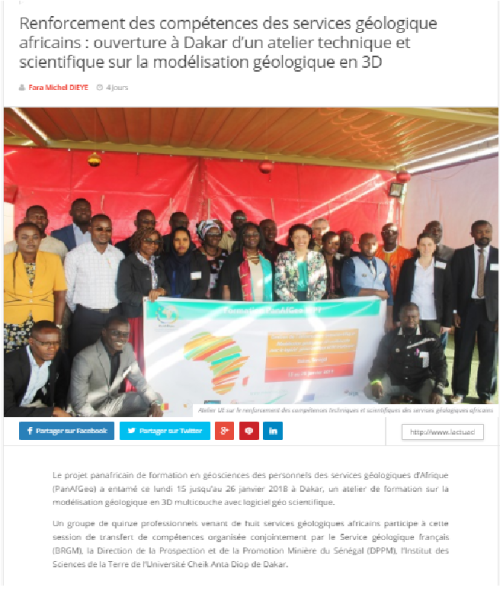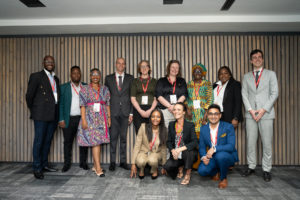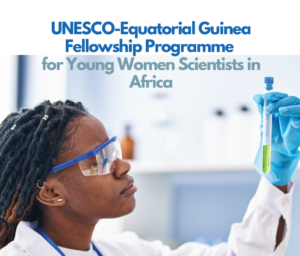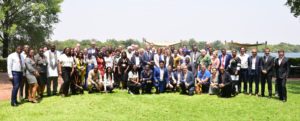Work-Package 6 – Geoheritage
Session WP6-2: Dodoma, Tanzania
14-19 May 2018
Brief description of the course content and visited places
Venue: Hotel Nashera, Dodoma, capital of Tanzania
Coordinator of WP6: Enrique Díaz-Martínez, Geological Survey of Spain (IGME).
Co-Coordinator of WP6-2: John D. Kalimenze, Geological Survey of Tanzania (GST).
The second session of Work-Package 6 on Geoheritage, a 6-day training programme on geoconservation provided by the PanAfGeo project, was held in Dodoma, Tanzania, from 14th to 19th of May 2018. Over 50 applications were received and carefully examined before the course, and 31 of them were approved and selected. The final list of trainees included personnel from the geological surveys of 11 African countries, as well as 6 professionals from the staff of the Ngorongoro UNESCO Global Geopark (UGG). The training team included a trainer from the Geological Survey of Tanzania (GST), two from the Geological Survey of Spain (IGME), and one from the Ngorongoro Conservation Area Authority (NCAA) and UGG.
The welcoming address at the opening ceremony was given by Maruvuko E. Msechu, acting CEO of the GST, followed by introductory lectures by Enrique Díaz-Martínez, WP6 leader. A comprehensive overview of the geology and geoheritage of Tanzania was provided by John D. Kalimenze, of the GST.
During the training, lectures and presentations of case studies were given, covering the main concepts and methodologies used in geoheritage studies: inventories, value assessment, legislation, geoconservation, management and public use, including geoparks, geotourism and public outreach. During both the discussions and fieldwork, case studies of geoheritage from African countries were used as examples, giving the opportunity to the participating staff from Ngorongoro NCAA and UGG to showcase their geoheritage.
Field work took place during three days and allowed to observe and discuss in situ some Tanzanian geological sites of interest for discussion and practical considerations. The type locality of yoderite, a rare mineral very rarely found in the world, was used as an example of a small geosite with very high scientific value. The methodology for geosite value assessment was applied through team work, to understand the process which helps establish the potential use and priorities for management and conservation. The World Heritage site of Kondoa rock paintings at Kolo was used as an example of cultural heritage of international relevance, but without any geoheritage of international relevance. This allowed to assess the difference between natural and cultural heritage, as well as between the different administrative levels of relevance. Finally, the Lake Bahi was used as an example of large geosite representative of geological processes related with the East African Rift.
The lectures provided during the training session were:
– Geoheritage training course and PanAfGeo project, aims and scope. EDM and JK
– The potential of geological survey organizations in geoconservation. EDM
– Geology and geoheritage in the trainees´ countries (10 min talks)
– Geoheritage, geodiversity and geoconservation concepts. EDM
– Investigation and evaluation of geological heritage. JK
– International, national and local legislation: examples and perspectives. EDM
– Methodology of the Global Geosites project. EDM
– Moveable geoheritage: geoconservation of fossil, mineral, rock and meteorite collections. JVS
– Methodologies for the inventory and identification of geoheritage. JVS
– Description of geoheritage sites: record cards, mapping and data base. JVS
– Evaluation of geoheritage sites: value, vulnerability and risk of degradation. EDM
– The Spanish Inventory of Geoheritage. JVS
– Geotourism and public outreach. JVS and EDM
– UNESCO Global Geoparks: examples and role of National Committees. EDM
– Geology and geoheritage inventory of the Ngorongoro Conservation Area. JK
– Ngorongoro-Lengai: from the proposal to management of a UNESCO Global Geopark. JM
– Perspectives for UNESCO Global Geoparks in Africa. JM and EDM
– Geoconservation in natural and cultural protected areas. EDM
– Final conclusions and future perspectives. JVS and EDM
During the training, a Whatsapp group of PanAfGeo WP6-2 participants was created by the trainees to exchange practical information, photos and documents. All trainees were supplied with printed copies of lecture presentations, as well as the corresponding digital files in a USB drive (PanAfGeo wrist band) also including other useful documents and reference material. Attendance to the course was 100%, and certificates were presented to all trainees and trainers at the official closure event on the last day. A successful and lively party was organized afterwards, with opportunities to learn traditional dances and taste the local gastronomy.
After the training, an evaluation form was distributed to all participants and feedback was received in the form of filled questionnaires. All responses were positive, including suggestions and constructive remarks for future sessions.
Many thanks are due to the Kondoa Kolo WHS personnel (particularly to the Site Manager, Zuberi Mabie) and the NCAA and UGG personnel (particularly Joshua Mwankunda, Manager of the Cultural Heritage Department) for their interest in and help with the training, and above all to the personnel of the GST at Dodoma (particularly John Kalimenze) for their help and support with the logistics and organization of the training.









